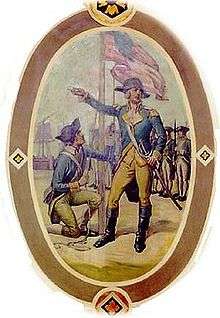Jean François Hamtramck

Jean-François Hamtramck (sometimes called John Francis Hamtramck) (1756–1803) was an officer who served in the US Army during the American Revolutionary War and the Northwest Indian War.
Life and career
Hamtramck, of French heritage, was born in Montreal, Canada (then part of New France). He joined the Continental Army as a captain in 1776, and became a decorated officer in the American Revolutionary War. He returned to the Army in 1785, and in 1787, he was made commander of Fort Vincennes in the Illinois Country, where he negotiated a peace treaty with local Indian tribes.
In Autumn 1790, Major Hamtramck was ordered to move against Indian villages on the Wabash, Vermilion, and Eel rivers to create a distraction from the campaign led by General Josiah Harmar. The Hamtramck expedition consisted of his own garrison, with militia from the local French residents and Kentucky. They found only one empty village, and lacked the supplies to reach more villages with the full force. Hamtramck returned to Vincennes, learning later that a force of 600 warriors from the Wabash Confederacy had assembled to fight—nearly double his own force. Hamtramck considered the Wabash force evidence that his primary mission had been accomplished.[1]
A year later, 4 November 1791, Major Hamtramck commanded a detachment of the First United States Regiment when he heard cannon fire. He commanded his Soldiers to load their weapons and fix bayonets, but encountered militia fleeing from St. Clair's Defeat who informed him that the rest of the Army had been destroyed. Hamtramck ordered the majority of his command to secure Fort Jefferson, and was later criticized by Lieutenant Colonel William Darke for failing to come to the aid of the retreating Army.[2]
In 1793, Hamtramck was named Lieutenant Colonel in the Legion of the United States, led by General Anthony Wayne to secure the Northwest Territory. Hamtramck was cited for bravery at the Battle of Fallen Timbers in 1794. Hamtramck was subsequently appointed as the first commandant of Fort Wayne, where he co-owned a large farm with his friend, William Wells.[3] In 1796, he led the garrison to secure Fort Maumee. He was then transferred to Fort Lernoult (later renamed Fort Shelby) and the settlement of Detroit for the United States on 11 July 1796.
He was promoted to Colonel in 1802, and remained commandant of Detroit until his death on 11 April 1803,[4] living in a house on land that is now Gabriel Richard Park near the present bridge to Belle Isle. He was buried at Ste. Anne de Detroit Catholic Church. The officers under his command placed a stone to mark his grave, as a "grateful tribute to his merit and his worth."[4] His body was moved in 1817 to the new Saint Anne's, then, in 1869, to Mount Elliott Cemetery.
In 1827, one of the four townships in Wayne County was named for him, a portion of which later became the city of Hamtramck, Michigan.[5]
In the 1960s Col. Hamtramck's remains were moved to Hamtramck, Michigan, the city formed from the township named in his honor. His grave site is incorporated into the Veterans Memorial at the entrance to Veterans Memorial Park, which is the main city park in Hamtramck, Michigan. This monument and the Beth Olem Jewish cemetery are the only remaining grave sites in the City of Hamtramck. The grave site is a Michigan historical marker site. The grave marker text reads:
- Colonel John Francis Hamtramck, Esq.
- The First United States Regiment of Infantry and Commandant of Detroit and its dependencies.
- He departed this life on the 11th of April 1803 aged 48 years, 7 months and 28 days.
- True patriotism and zealous attachment to national liberty joined to a laudable ambition led him into military service at an early period of his life.
- He was a soldier even before he was a man. He was an active participant in all the dangers, difficulties and honors of the revolutionary war, and his heroism and uniform good conduct procured him the attention and personal thanks of the immortal Washington.
- The United States in him have lost a valuable officer and a good citizen, and society a useful and pleasant member.
- To his family his loss is incalculable, and his friends never forget the memory of Hamtramck. This humble monument is placed over his remains by the officers who had the honor to serve under his command- A small but grateful tribute to his merit and his worth.
- This inscription was restored by the Catholic Study Club of Detroit, Michigan May 30th 1928.
Notes
- ↑ Barnhart, pp 287-288
- ↑
- Sword, Wiley (1985). President Washington's Indian War: The Struggle for the Old Northwest, 1790-1795. Norman and London: University of Oklahoma Press. p. 190. ISBN 0-8061-1864-4.
- ↑ Poinsatte, 36
- 1 2 The First Regiment of Infantry compiled in the office of the Military Service Institution. Website accessed 9 April 2009.
- ↑ City of Hamtramck, Michigan
References
- Barnhart, John D. and Riker, Dorothy L. (1971). Indiana to 1816. The Colonial Period. Indiana Historical Society. ISBN 0-87195-109-6.
- Poinsatte, Charles (1976). Outpost in the Wilderness: Fort Wayne, 1706–1828. Allen County, Fort Wayne Historical Society.
External links
- Farmer, Silas. (1884) (Jul 1969) The history of Detroit and Michigan, or, The metropolis illustrated: a chronological cyclopaedia of the past and present: including a full record of territorial days in Michigan, and the annuals of Wayne County, in various formats at Open Library.
- Placement of Hamtramck's grave marker